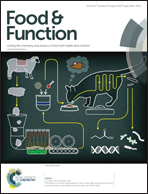Lactoferrin level in breast milk: a study of 248 samples from eight regions in China
Abstract
Lactoferrin plays an important role in infant gastrointestinal health and immunity responses. This study measured the change of the lactoferrin level in breast milk over the lactation time in Chinese women, and explored potential influencing factors in terms of various maternal factors. 248 lactating women were recruited from eight different regions across China, covering 330 days of lactation. The nutrition information of each woman as well as the gender information of infants were collected. Breast milk lactoferrin level was determined by ultra-performance liquid chromatography (UPLC). A twenty-four-hour maternal food recall was used to collect the dietary information. The lactoferrin level decreased progressively from day 1 to day 30 (p < 0.01), and remained constant from day 31 to day 330. Among the eight regions, the breast milk samples from Gansu contained the highest mean lactoferrin level (1.40 g L−1) while the breast milk samples from Zhejiang contained the least mean lactoferrin level, 0.94 g L−1 (p < 0.01). Dietary pattern and maternal BMI showed no correlation with the breast milk lactoferrin level. Maternal ethnicity and age were associated with the breast milk lactoferrin level. The breast milk samples collected from Tibetan ethnicity had 1.45 g L−1 lactoferrin while those collected from Dai ethnicity had 1.02 g L−1 lactoferrin. Women in the elder age group (30 years old and above) had 0.95 g L−1 breast milk lactoferrin, which was significantly lower than the lactoferrin level (1.3 g L−1) in the younger age group (20–25 years old) (p < 0.01). In conclusion, this study showed that lactoferrin levels in the breast milk of Chinese lactating women were influenced by lactation time. Besides, ethnicity and maternal age were two impact factors on the breast milk lactoferrin level.



 Please wait while we load your content...
Please wait while we load your content...